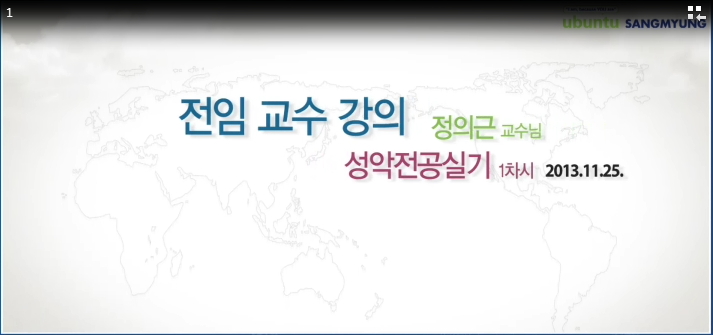Soun-Nam Kim(1917-1983) was one of the first-generation Korean composers of the 20th century, and lived in North Korea after he crossed the border for political reasons in 1948 until his death. HIS activity as a composer in South Korea was confined to...
http://chineseinput.net/에서 pinyin(병음)방식으로 중국어를 변환할 수 있습니다.
변환된 중국어를 복사하여 사용하시면 됩니다.
- 中文 을 입력하시려면 zhongwen을 입력하시고 space를누르시면됩니다.
- 北京 을 입력하시려면 beijing을 입력하시고 space를 누르시면 됩니다.
부가정보
다국어 초록 (Multilingual Abstract)
In spite of this circumstances, as soon as the ban was lifted in 1988, researches on him and his works were prompted, in that he was a major historical figure who set forth music of a new mode which contains national traits and at the same time sounds modem for the new era(around the time of Liberation from Japanese colonial ruling). Though Soun-Nam Kim was well acquainted with Western music and learned it s compositional techniques in universities in Japan, he was, more than anyone else, eager to accommodate traditional Korean musical elements into the frame of Western music to shape the modernized Korean music.
The purpose of this thesis is to trace his techniques of that accommodation in depth through the analysis of his entire works(published 41 pieces including 2 composed in the North). These are classified into four categories according to the genre with separate subtitles: monophonic song(%), art song(l31, instrumental music(2), and works for chorus and orchestra(1). And each of them are examined systematically focussing in turn on text(if it is the category of song or contains a text), mode, characteristics of melodic progression, tonality and harmony, meter and rhythm.
The contents of the texts can be divided roughly into three: hear-stirring one with leftists ideology(monophonic songs; a work for chorus and orchestra), expressionistic one with tinge of that ideology and/or folklike atmosphere(4-5 art songs), lyrical one in Korean emotional manner(5; especially 3, lullaby(3).
Concerning musical elements, Western ones employed are (modified) major/minor, chromaticism, skips with large intervals, structure organized by intervallic relationship(1ike Bartok), added harmony, cluster, thick texture, frequently shifted accents(in the manner of Stravinsky), importance of variational technique, etc.
Upon this, Korean elements combined are pentatonic scale, a typical Korean scale often called saeya (upward progression of two intervals, the perfect 4th and the 2nd), ornamental formulae, typical beginning and ending intervals of the melody, traditional rhythmic patterns, etc. One of the most notable techniques he executed seems to be that the notes (especially from the 'saeya scale) he applied in the melody are frequently applied also as the essential notes of harmony so that added harmony or cluster are resulted in the Western manner.
Soun-Nam Kim(1917-1983) was one of the first-generation Korean composers of the 20th century, and lived in North Korea after he crossed the border for political reasons in 1948 until his death. HIS activity as a composer in South Korea was confined to a little less than 4 years(194-1948), and much less, his works had been officially banned to be performed from 1948.
In spite of this circumstances, as soon as the ban was lifted in 1988, researches on him and his works were prompted, in that he was a major historical figure who set forth music of a new mode which contains national traits and at the same time sounds modem for the new era(around the time of Liberation from Japanese colonial ruling). Though Soun-Nam Kim was well acquainted with Western music and learned it s compositional techniques in universities in Japan, he was, more than anyone else, eager to accommodate traditional Korean musical elements into the frame of Western music to shape the modernized Korean music.
The purpose of this thesis is to trace his techniques of that accommodation in depth through the analysis of his entire works(published 41 pieces including 2 composed in the North). These are classified into four categories according to the genre with separate subtitles: monophonic song(%), art song(l31, instrumental music(2), and works for chorus and orchestra(1). And each of them are examined systematically focussing in turn on text(if it is the category of song or contains a text), mode, characteristics of melodic progression, tonality and harmony, meter and rhythm.
The contents of the texts can be divided roughly into three: hear-stirring one with leftists ideology(monophonic songs; a work for chorus and orchestra), expressionistic one with tinge of that ideology and/or folklike atmosphere(4-5 art songs), lyrical one in Korean emotional manner(5; especially 3, lullaby(3).
Concerning musical elements, Western ones employed are (modified) major/minor, chromaticism, skips with large intervals, structure organized by intervallic relationship(1ike Bartok), added harmony, cluster, thick texture, frequently shifted accents(in the manner of Stravinsky), importance of variational technique, etc.
Upon this, Korean elements combined are pentatonic scale, a typical Korean scale often called saeya (upward progression of two intervals, the perfect 4th and the 2nd), ornamental formulae, typical beginning and ending intervals of the melody, traditional rhythmic patterns, etc. One of the most notable techniques he executed seems to be that the notes (especially from the 'saeya scale) he applied in the melody are frequently applied also as the essential notes of harmony so that added harmony or cluster are resulted in the Western manner.
목차 (Table of Contents)
- Ⅰ. 시작하면서
- Ⅱ. 김순남의 생애
- Ⅲ. 시기별 작품분류
- Ⅳ. 장르별 음악적 특징
- Ⅴ. 끝내면서
- Ⅰ. 시작하면서
- Ⅱ. 김순남의 생애
- Ⅲ. 시기별 작품분류
- Ⅳ. 장르별 음악적 특징
- Ⅴ. 끝내면서
동일학술지(권/호) 다른 논문
-
- 민족음악학회
- 김용환
- 2003
- KCI등재
-
- 민족음악학회
- 제갈삼
- 2003
- KCI등재
-
- 민족음악학회
- 홍정수
- 2003
- KCI등재
-
- 민족음악학회
- 신인선
- 2003
- KCI등재





 KISS
KISS





